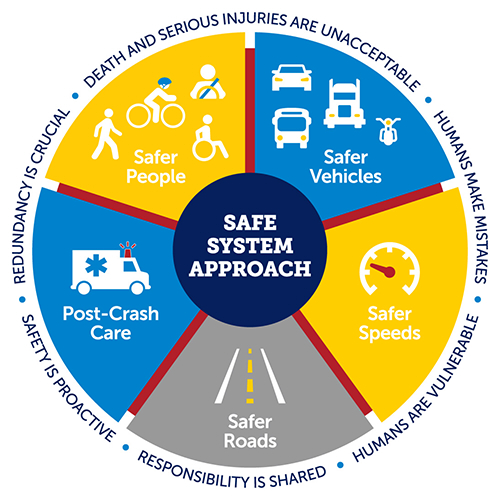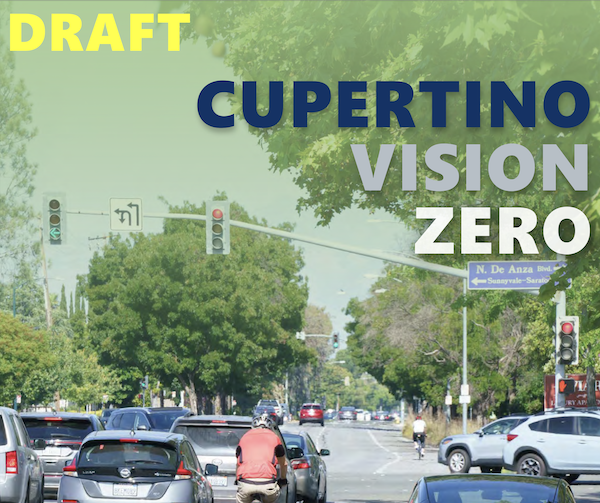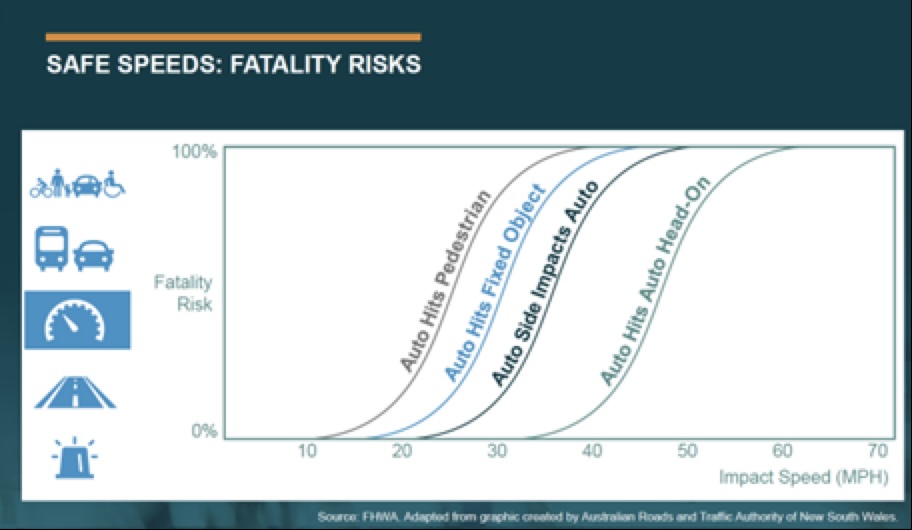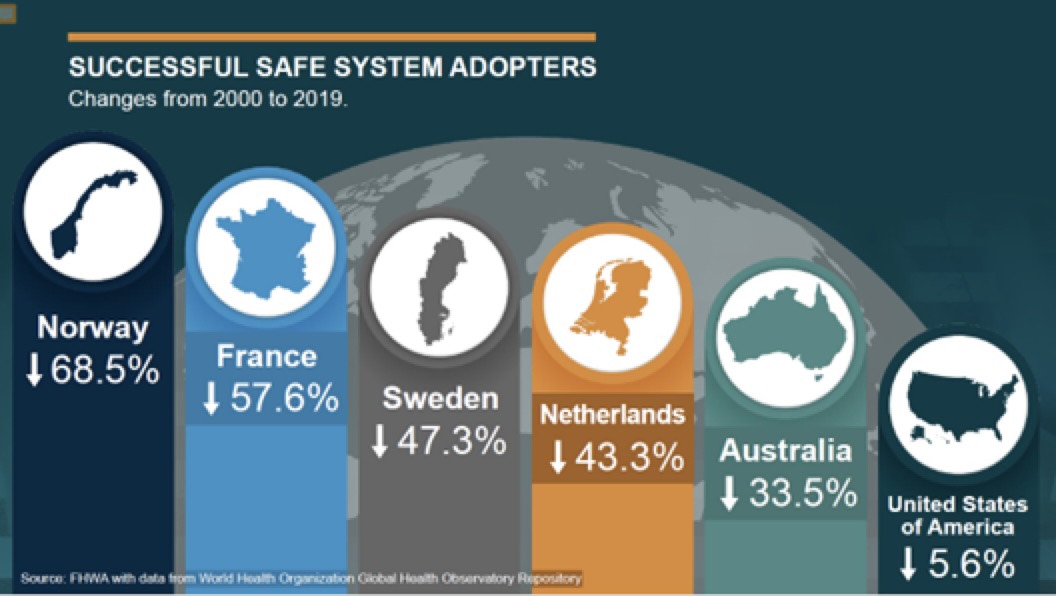The City of Cupertino is moving closer to having a Vision Zero plan. The fundamental goal of Vision Zero is to eliminate all deaths and serious injuries to users of our roadway system, including vehicle drivers and passengers, bicyclists, pedestrians and others. (This metric is typically called “KSI” for Killed or Severely Injured.)
Historically, surface transportation infrastructure in the United States has focused disproportionately on moving vehicles as efficiently as possible. Vision Zero represents a paradigm shift towards prioritization of a safe and equitable transportation system for all users. This will require slowing vehicle speeds to decrease impact forces, which is highly correlated to fatalities and serious injuries. WBC strongly supports making our streets safer for all users, especially our most vulnerable, which are cyclists and pedestrians.
The cover of the draft plan is shown above. To read the current draft plan, click here.
The Bike Ped Commission voted unanimously on March 28 not to recommend to the City Council the Vision Zero Plan created by TJKM consultants as it is currently written.
Overall, they expressed a lack of confidence that the plan as written would make any difference in deaths or serious injuries in our city, as Vice-Chair Wolf clearly stated.
Commissioners cited many reasons, including:
■ Missing obvious streets like Bubb and Blaney in the Recommended Projects and lack of any specific intersection improvements;
■ Lack of focus toward and targeted improvements for students;
■ Misleading notes on current city projects and counterintuitive toolbox ratings for the efficacy and cost of potential improvements;
■ Missing recommendations for simple quick build safety implementations and for city ordinances that would advance safety;
■ Lack of a recommended robust process to measure progress except through a long-term review of police data.
The commissioners provided suggestions and examples of these items so the consultants would understand what is expected in the plan.
What happens next
The Bike Ped Commissioners have until April 8 to provide their detailed feedback to the consultants. The Vision Zero Plan will then be revised by the consultants based on this feedback.
The City Staff will then share the revised Vision Zero Plan on the City of Cupertino website at least 15 days before the BPC meeting at which it will be discussed again (either in May or June 2024). This will allow residents and the BPC Commissioners a chance to review the revised plan in detail before that meeting.
If the commissioners are comfortable with the updated draft report, they will recommend to the City Council that they adopt the plan.
Why Vision Zero is needed
Travel on our U.S. roadways is relatively dangerous for all users. Over a ten-year period (2012-2021) there have been over 336,000 traffic-related deaths in the United States (per NHTSA FARS data). This number includes over 58,000 pedestrian and 8,300 bicyclist deaths.
By comparison, commercial air travel has essentially reached the Vision Zero goal. In the same 10-year period (2012-2021) there have been only 2 deaths in the United States associated with this mode of travel. The general public has come to expect this level of safety performance for air travel. Vision Zero recognizes we should have the same level of safety on our roadway system. Locally, San Jose, Sunnyvale and Fremont have adopted Vision Zero plans.

Between 2012-2021, Cupertino suffered 9 fatalities and 74 serious injuries or 83 KSI (Killed of Seriously Injured). Traffic accidents are the number one cause of death for school-age children in California, but the state has some of the fastest school zone speeds in the country, according to State Assembly member Mark Berman in a recent artcile in the Mercury News.* Streetsblog SF recently stated “Just as the United States is an outlier among peer nations for gun deaths, it is an outlier for road deaths, particularly for people on foot or bikes. Among U.S. states, California is ranked 43rd and 42nd in pedestrian and bicycle safety respectively. Road deaths have been the leading cause of child death—by far—for decades, surpassed by guns only in 2020. That is not because U.S. roads got safer, but because gun deaths got much worse.” **
Implementation
Practical implementation of Vision Zero in any city is achieved through such measures as road diets, speed humps, protected bike lanes, LED street lighting for better visibility, refuge medians, shorter crossing distances, and coordinated public education and engagement.
One of the most effective tools for reducing fatalities and serious injuries is the reduction in speed limits, as the greater the traffic speed, the more serious or fatal a collision is.
Changes to roadways can be controversial, especially for drivers that are used to the old way of focusing on moving automobiles as efficiently as possible instead of focusing on safety for all users. Some of the more controversial actions often included in Vision Zero recommendations are speed limit reductions and reallocation of street space for road diets, bike lanes and transit corridors, sometimes with a loss of street parking. These can have vocal detractors.
Push back on implementation is likely one reason that the U.S. has not seen anywhere close to the improvements that other western nations have seen after implementing Vision Zero. A paradigm shift is necessary before the U.S. can expect to realize similar gains in safety.
WBC is pleased that the plan will be revised to address the concerns of the Commissioners and the public. We look forward to the update, and will be sharing key information from the plan when it is recommended by the BPC. Vision Zero as a whole has some great goals–no one wants to have any deaths or serious injuries from collisions in our city–and we are glad that it is moving toward a plan that is accurate, complete, and substantial.
Have some input on changes you would like to see in the draft plan? Email the city staff and commission here.
* https://www.mercurynews.com/2024/03/28/new-california-bill-proposes-lowering-school-speed-limits-to-20-mph/?share=oshfrolir2ywfwrwtnpn
** https://sf.streetsblog.org/2024/03/27/guest-commentary-traffic-engineers-must-put-safety-over-driver-throughput
The information in this article is solely the opinion of Walk-Bike Cupertino and does not reflect the opinions of any other organization or entity. For more information, contact WBC at info@walkbikecupertino.org.



